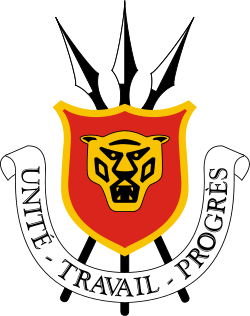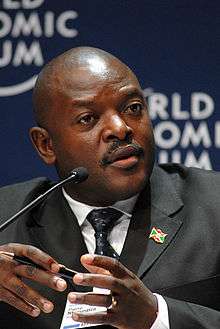Burundian Civil War
| Burundian Civil War | |||||||
|---|---|---|---|---|---|---|---|
 Tutsi militia near the Zairian border, 1996 | |||||||
| |||||||
| Belligerents | |||||||
|
Government forces: Supported by: |
Hutu militias: Tutsi militias | ||||||
| Strength | |||||||
|
6,000 (1993)- 40,000 (2000) | ? | ||||||
| Casualties and losses | |||||||
| Total: c. 300,000 killed[1] | |||||||
Part of a series on the |
||||||||||
|---|---|---|---|---|---|---|---|---|---|---|
| History of Burundi | ||||||||||
 | ||||||||||
| Tutsi / Hutu / Twa origins | ||||||||||
|
||||||||||
|
||||||||||
|
|
||||||||||
|
| ||||||||||
The Burundian Civil War was an armed conflict lasting from 1993 to 2006. The civil war was the result of long standing ethnic divisions between the Hutu and the Tutsi ethnic groups in Burundi. The conflict began following the first multi-party elections in the country since independence from Belgium in 1962, and is seen as formally ending with the swearing in of Pierre Nkurunziza in August 2005. The estimated death toll stands at 300,000 killed.[2]
Background
Prior to colonialism, Burundi was led by a Tutsi monarchy like its neighbor Rwanda. The Belgians and the Germans found it convenient to rule through the existing power structure in which the Tutsi were already dominant over the Hutu. They therefore perpetuated Tutsi domination. The Belgians generally identified the peoples of Burundi and Rwanda with the following observations: the Twa who were short, the Hutu who were of medium height and the Tutsi who were tallest among them. Those individuals who owned more than ten cows were normally described as Tutsi.
After the independence of the Belgian Congo and colonies across Africa from 1960, Belgian administrators in Ruanda-Urundi began to prepare the territory for independence. Following independence in 1962, a federation with Rwanda was rejected, and Rwanda and Burundi separated. Unlike Rwanda, Burundi chose to retain its monarchy.
Burundi’s first multi-party national elections were held on 27 June 1993. These elections were immediately preceded by 25 years of Tutsi military regimes, beginning with Michel Micombero, who had led a successful coup in 1966 and replaced the monarchy with a presidential republic. Under the Micombero regime, the minority Tutsi generally dominated governance. In 1972, an all-Hutu organization known as Umugambwe w'Abakozi b'Uburundi or Burundi Workers' Party (UBU) organized and carried out systematic attacks on ethnic Tutsi, with the declared intent of annihilating the whole group. The military regime responded with large-scale reprisals targeting Hutus. The total number of casualties was never established, but estimates for the Tutsi genocide and the reprisals on the Hutus together are said to exceed 100,000. As many refugees and asylum-seekers left the country for Tanzania and Rwanda.
The last of the coups was in 1987 and installed Tutsi officer Pierre Buyoya. Buyoya attempted to institute a number of reforms to ease state control over media and attempted to facilitate a national dialogue. Instead of helping the problem, these reforms instead served to inflame ethnic tensions as hope grew amongst the Hutu population that the Tutsi monopoly was at an end. Local revolts subsequently took place by Hutu peasants against several Tutsi leaders in northern Burundi; these Hutu militias killed hundreds of Tutsi families in the process. When Buyoya sent in the army to quell the uprising, they in turn killed thousands of Hutu.
War
On October 21, 1993, Burundi's first democratically elected Hutu president, Melchior Ndadaye, was assassinated by Tutsi extremists. As a result of the murder, violence broke out between the two groups, and an estimated 50,000 to 100,000 people died within a year. A 1996 UN report into Ndadaye's assassination and its aftermath, concluded that "acts of genocide against the Tutsi minority were committed in Burundi in October 1993".[3] The report also implicated senior figures in Burundi's Tutsi-dominated army in the assassination. In Burundi, Tutsi civilians have been targets of mass killings and acts of genocide organized by the state and by armed militia groups (see Burundi genocide (1993)). They were followed by a long civil war that killed both Hutu and Tutsi.
Assassination of Ntaryamira
In 1994, Ndadaye’s successor Cyprien Ntaryamira was assassinated in the same plane crash with Rwandan President Juvenal Habyarimana. This act marked the beginning of the Rwandan Genocide, while in Burundi, the death of Ntaryamira exacerbated the violence and unrest, although there was no general massacre. Sylvestre Ntibantunganya was installed to a 4-year presidency on April 8, but the security situation further declined. The influx of hundreds of thousands of Rwandan refugees and the activities of armed Hutu and Tutsi groups further destabilized the regime.
After the assassination of Ntaryamira the Hutu presidency and Tutsi military operated under a power-sharing political system until 1996, when Tutsi Pierre Buyoya replaced the Hutu president in a coup. Hutu rebels killed about 300 Tutsis on July 20, 1996,[4] and army soldiers killed at least 126 Hutu refugees on January 5, 1997.[5] In 1998, Buyoya and the opposition-led Hutu parliament reached an agreement to sign a transitional constitution, and Buyoya was sworn in as president. The Arusha peace talks began on 15 June 1998.[6]
The civil war, however, continued, despite the efforts of the international community to create a peace process. Ceasefire talks were held in Tanzania in 2000, facilitated by Nelson Mandela. An agreement was reached which established a transitional government, where the presidency and vice-presidency would be rotated every 18 months, sharing power between the Hutus and Tutsis. While the government and three Tutsi groups signed the ceasefire accord, two leading Hutu rebel groups refused to participate, and the fighting continued. The Arusha talks closed with little progress made on November 30, 2000.[7] 20 Tutsis and one British woman were killed on 28 December 2000, in the Titanic Express massacre.
On 18 April 2001, an attempted coup failed.[8] The transitional government was implemented in October 2001. 300 boys were kidnapped from Museuma College on November 9, 2001.[9] The main Hutu rebel groups had still refused to sign a ceasefire agreement at this time, and 500 rebels were killed in their own attack against the Tutsi army on December 25, 2001.[10] This resulted in increased fighting for several months. The 9 September 2002 Itaba massacre left hundreds of unarmed civilians dead.
Presidency of Ndayizeye

On 9 April 2003, the force headquarters of the African Union Mission in Burundi was established in Bujumbura under South African Major General Sipho Binda. On 18 October 2003, it was announced that the mission had reached full strength: 1,483 South Africans, 820 Ethiopians, and 232 personnel from Mozambique.[11]
In July 2003, a rebel attack on Bujumbura left 300 dead and 15,000 displaced.[12] Also in July, Domitien Ndayizeye, a Hutu, took over as president of the transitional government, and Buyoya stepped down. Along with the main Hutu rebel group, National Council for the Defense of Democracy–Forces for the Defense of Democracy (FDD), President Ndayizeye signed a ceasefire agreement at a summit of African leaders in Tanzania in November 2003. Under the agreement, the FDD became a political party, and it was decided that rebel Hutu fighters were to be integrated into the predominantly Tutsi armed forces. On December 29, 2003, Archbishop Michael Courtney, the papal nuncio for the country, was murdered.
Disaster occurred in 2004 when the Hutu rebel group, Forces of National Liberation (FNL), claimed responsibility for killing 160 Congolese Tutsi refugees in a United Nations camp at Gatumba near the Congo border in Burundi. The attack was strongly condemned by the U.N. Security Council, which issued a statement of outrage at the fact that "most of the victims were women, children and babies who were shot dead and burned in their shelters.[13] The Council called on the top U.N. envoy in Burundi to investigate the incident with a U.N. representative from Congo, a step that increased U.N. intervention in the Burundi civil war. A few months later in December, U.N. and government forces began to disarm thousands of Burundi soldiers and former rebels.
Peace process
.jpg)
In 2005, many developments were made in the peace process. The president signed a law in January 2005 to initiate a new national army, consisting of Tutsi military forces and all but one of the Hutu rebel groups. The Constitution was approved by voters in a referendum—marking the first time Burundians had voted since 1994. They voted again in July during the parliamentary elections, postponed from November 2004,[14] in which "the Government of Burundi and the Independent National Electoral Commission conducted a technically-sound election, carried out in an atmosphere of peace and security."[15] The FDD ended up winning the parliamentary elections. Several months later, Pierre Nkurunziza, from the Hutu FDD group, was elected as president by the two Hutu-dominated houses of parliament.
After 12 years of living with a midnight-to-dawn curfew, Burundians were free to stay out late when the curfew was lifted on April 15, 2006, for the first time since 1993.[16] This signified the most stable point in Burundian civil affairs since the assassination of Hutu President Melchior Ndadaye and the beginning of the civil war.
Matters continued to look promising after Burundi’s last rebel group, the Forces of National Liberation (FNL) signed a ceasefire deal in Tanzania, "solidifying the end of a 12-year civil war."[17][18] As part of the agreement, members of the FNL were to be assembled, demobilized, and integrated into the national army. In mid-April 2008, FNL rebels shelled the capital, Bujumbura, while fighting killed at least 33.[19]
References
- ↑ "Heavy shelling in Burundi capital". BBC News. April 18, 2008. Retrieved April 27, 2010.
- ↑ "Heavy shelling in Burundi capital". BBC News. April 18, 2008. Retrieved April 27, 2010.
- ↑ "Part V: Recommendations - II. Genocide" (PDF). International Commission of Inquiry for Burundi. Retrieved 2009-06-29.
- ↑ "Archived copy". Archived from the original on 2010-06-02. Retrieved 2009-01-02.
- ↑ "Burundi Army Admits It Killed 126 Hutu Refugees". The New York Times. January 12, 1997. Retrieved April 27, 2010.
- ↑ "IRIN Update 437 for 13-15 June 98.6.15". Retrieved 1 November 2014.
- ↑ "Burundi peace talks close with little progress". CNN. November 30, 2000. Retrieved April 27, 2010.
- ↑ "Burundi coup attempt falters, army says". CNN. April 18, 2001. Retrieved April 27, 2010.
- ↑ "300 boys kidnapped in Burundi". CNN. November 9, 2001. Retrieved April 27, 2010.
- ↑ "Burundi army 'kills 500 rebels'". BBC News. December 25, 2001. Retrieved April 27, 2010.
- ↑ Helmoed-Romer Heitman, 'Burundi mission at full strength,' Jane's Defence Weekly, 29 October 2003, 16
- ↑ "Archived copy". Archived from the original on 2005-11-15. Retrieved 2009-01-02.
- ↑ "U.N. Demands Justice After Massacre of 150 Refugees in Burundi". The New York Times. 2004-08-16. Retrieved 2009-06-29.
- ↑ "Burundi peace poll postponed". BBC News. 2004-10-15. Retrieved 2009-06-29.
- ↑ "Burundi Civil War". Global Security. 11-7-2011. Retrieved 2012-10-21. Check date values in:
|date=(help) - ↑ Lacey, Marc (April 15, 2006). "Burundi: Curfew Lifted After 13 Years". The New York Times. Retrieved April 27, 2010.
- ↑ "Burundi Rebel Group Expected to Disarm". The New York Times. 2004-08-16. Retrieved 2006-09-10.
- ↑ John Pike. "BURUNDI: Last rebel group signs cease-fire with government". Retrieved 1 November 2014.
- ↑ Burundi rebels shell capital : Mail & Guardian Online Archived May 23, 2012, at the Wayback Machine.
External links
- Burundi Civil War, globalsecurity.org
- Chronology for Hutus in Burundi
- A Heroine of the Burundian Civil War at BBC World Service